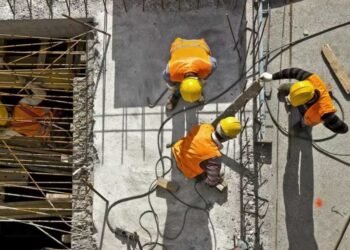With tight schedules, strict safety regulations, and the ever-present pressure to reduce costs, having the right construction equipment can make all the difference. Did you know that construction sites with optimised equipment use can see a significant increase in productivity? This significant boost can translate to faster project completion times, reduced labour costs, and improved safety records.
Whether you are managing a large-scale commercial project or a smaller residential build, ensuring you have the best tools at your disposal is crucial. This article explores essential tools and systems that can transform your construction site operations, ensuring safety, efficiency, and cost-effectiveness.
Portable Stairs: The Versatile Access Solution
Portable stairs are designed to self-level, adjusting to the angle of the ground, which makes them perfect for excavation sites where levels are constantly changing. The modular design allows multiple stairs to be joined end-to-end to cover any length needed, providing flexible and secure access.
Compared to scaffold towers, portable stairs are quicker to set up and move, offering a more efficient and safer alternative to ladders for primary or secondary access. Utilising portable stairs not only enhances safety but also improves workflow efficiency by providing reliable access points throughout the site.
Edge Protection Fencing: Premium Safety on the Perimeter
Ensuring the safety of workers at the edges of slabs and elevated work areas is paramount. The Premium Edge Protection Fencing System by Safe Smart Access is an ideal solution. These framed panels are designed to endure harsh site conditions, making them a reliable choice for various construction environments.
The system is easy to install, with posts that bolt directly to the slab edge and panels that slide in and secure with a fixing bolt. Safety latches prevent the panels from unintentionally lifting off, providing a secure barrier. Available in heights of 1.5 meters and 2.0 meters, these panels are suitable for construction projects requiring robust edge protection. The fencing system not only meets but exceeds the relevant Australian standards for temporary edge protection, ensuring compliance and peace of mind. Its stackable design also facilitates easy storage and transportation, making it a practical and effective safety solution.
Temporary Bridges: Ensuring Safe Passage
Navigating construction sites often involves crossing trenches, canals, and other obstacles. Temporary bridges provide a safe and effective solution for these challenges. With a width of 1.2 meters, these bridges allow for two-way access, ensuring smooth and safe passage for workers and equipment. Modules can be joined to create spans of up to 21 meters, accommodating various site needs.
These bridges are designed to support heavy-duty loads, with a 2.5 kPa load rating, making them suitable for even the most demanding environments. Additional attachments are available for creating crane access bridges, further enhancing their versatility. End ramps ensure a smooth transition from ground level to the bridge deck, minimising trip hazards and improving accessibility. Temporary bridges not only enhance safety but also streamline site operations by providing reliable access across challenging terrains.
Truck Loading Platform: Streamlining Loading and Unloading
Loading and unloading materials from trucks is a common task on construction sites, and the right equipment can make this process much safer and more efficient. The SafeLoader Truck Loading Platform is specifically designed to facilitate these tasks. Featuring a self-closing gate and anti-slip treads on the stairs, this platform ensures secure and easy access to trucks.
The SafeLoader can handle heavy loads and meets the stringent AS 1657:2018 standards for safety. Available in lengths of 2, 4, and 6 meters, it includes crane lifting points for easy mobility and optional bolt-on forklifting channels. Its fully cross-braced aluminium frame provides a sturdy and reliable platform for various loading and unloading tasks, from construction materials to mining machinery. The SafeLoader’s design minimises fall hazards and enhances efficiency, making it an essential tool for any construction site looking to improve its loading operations.
Modular Scaffolding Systems: Flexibility and Safety Combined
Modular scaffolding systems are vital for providing secure and versatile access to various parts of a construction site. Unlike traditional scaffolding, modular systems can be easily assembled and adjusted to fit different project needs. This flexibility is particularly beneficial for projects with complex structures or those requiring frequent changes in scaffolding configuration.
These systems are designed to meet Australian safety standards, ensuring that workers have a safe platform to perform their tasks. The components are lightweight yet sturdy, making them easy to transport and assemble without compromising on stability. The adaptability of modular scaffolding systems enhances workflow efficiency, allowing teams to quickly reconfigure scaffolding as the project progresses. By investing in modular scaffolding, construction sites can significantly reduce setup times and improve overall safety.
Heavy-Duty Cranes: Lifting Productivity to New Heights
Cranes are indispensable for moving heavy materials on construction sites, and choosing the right crane can dramatically enhance productivity. Whether it’s a tower crane for high-rise buildings or a mobile crane for smaller sites, the right equipment ensures that materials are lifted and moved efficiently and safely.
Regular maintenance and proper training for crane operators are crucial to maximise the efficiency and safety of crane operations. Advanced features such as load monitoring systems and remote controls can further enhance precision and safety. By investing in high-quality, well-maintained cranes, construction sites can reduce the risk of accidents and keep projects on schedule, ultimately saving time and costs.
Advanced Safety Gear: Protecting Workers and Enhancing Efficiency
Safety gear is a critical component of any construction site, and advancements in technology have led to the development of more effective protective equipment. Helmets with integrated communication systems, high-visibility clothing, and advanced fall protection harnesses are just a few examples of modern safety gear that can significantly enhance worker safety.
Regular training and updates on the use of safety equipment are essential to ensure that all workers are protected and can perform their tasks efficiently. By investing in advanced safety gear, construction sites can reduce the risk of accidents and injuries, leading to a safer and more productive working environment.
Conclusion
Maximising efficiency on a construction site requires the right equipment and tools. From portable stairs and edge protection systems to modular scaffolding and heavy-duty cranes, each piece of equipment plays a vital role in enhancing site operations. Concrete mixers ensure quality in construction, while automated material handling systems streamline operations and reduce manual labour. Advanced safety gear protects workers, ensuring that projects are completed safely and efficiently.
By investing in the best equipment and keeping up with the latest advancements, Australian construction sites can improve productivity, reduce costs, and ensure the safety of their workers. In an industry where efficiency and safety are paramount, the right tools can make all the difference, leading to successful project completions and satisfied clients.











